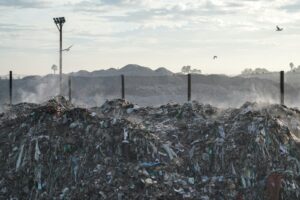Interview: How to deal with our growing e-waste mountain
 Environment Journal talks to Sebastien Farnaud, professor in bio-innovation & enterprise at Coventry University about the growing mountain of electric waste (e-waste) and what we can do to tackle it.
Environment Journal talks to Sebastien Farnaud, professor in bio-innovation & enterprise at Coventry University about the growing mountain of electric waste (e-waste) and what we can do to tackle it.
Over the past few decades, the amount of tech in our everyday lives has skyrocketed.
The average UK household now has over 9 different tech devices: a computer, tablet, mobile, smart-tv, speaker – the list goes on. But the shelf life of these products is minimal, with the average smartphone lasting just two years.
But what happens to these products when they reach the end of their life?
Of the 53.6 million tonnes of e-waste produced in 2019, only 17% was recycled.
This means that 83% was discarded through improper means, sent to landfill or shipped abroad to deal with it there.
Millions of people across the world are thought to work informally recycling these materials through open burning, exposing themselves and the environment to toxic fumes which then find their way into the water supply and food chain, poisoning animals and humans.
‘E-waste is not just another plastic,’ warns Professor Farnaud.
‘With plastic, we have this mountain of rubbish that we need to get rid of, with e-waste it is not that simple, because we actually need to reuse the components.’
With the race to net-zero well and truly underway, an increasing number of devices will need to be electrified – from electric vehicles to heat pumps and so we need to use these resources to help achieve this.
‘Many of the metals used in household tech products are essential for electrification, they are critical elements that we are running out of, we simply don’t have enough,’ warns Professor Farnaud.

‘Currently, there are two main methods used to recycle e-waste at scale.
‘You have hydrometeorology, which involves using a strong acid to dissolve the metal. Or pyrometallurgy, which involves using really strong heat so it has a very large carbon footprint.’
However, Professor Farnaud is an expert in another method – bioleaching.
‘Bioleaching is very simple, it’s been around for billions of years.
‘You simply use bacteria and you feed them with the metals, the bacteria oxidise the metals in order to survive and then once the metal is oxidised it turns from a solid back into a solution. Once you’ve got your solution in your bacterial growth, then you can extract it and you’ve got a pure metal. It doesn’t involve high temperatures, the bacterias are non-toxic, we don’t use strong acid and at the end, you get a very selective metal that can be used in the supply chain.’
However, despite the benefits of this method, at the moment it is not widely used.
‘Most of the large tech industries are really interested in this method, but at the moment, recycling is not compulsory.
‘Once there is policy to force these companies to ensure that what they’re making is recyclable then I think we will see an increase, but we need more funding, we need more support.
‘In a circular economy it’s important that you don’t just wait until the end when we have no resources left, we need to work with the designers, manufactures and the recyclers so that we can build these devices in a way that makes sure they can be recycled.
‘The proof of concept is there, we just need to do it now.’
Photo by Chris Ried















